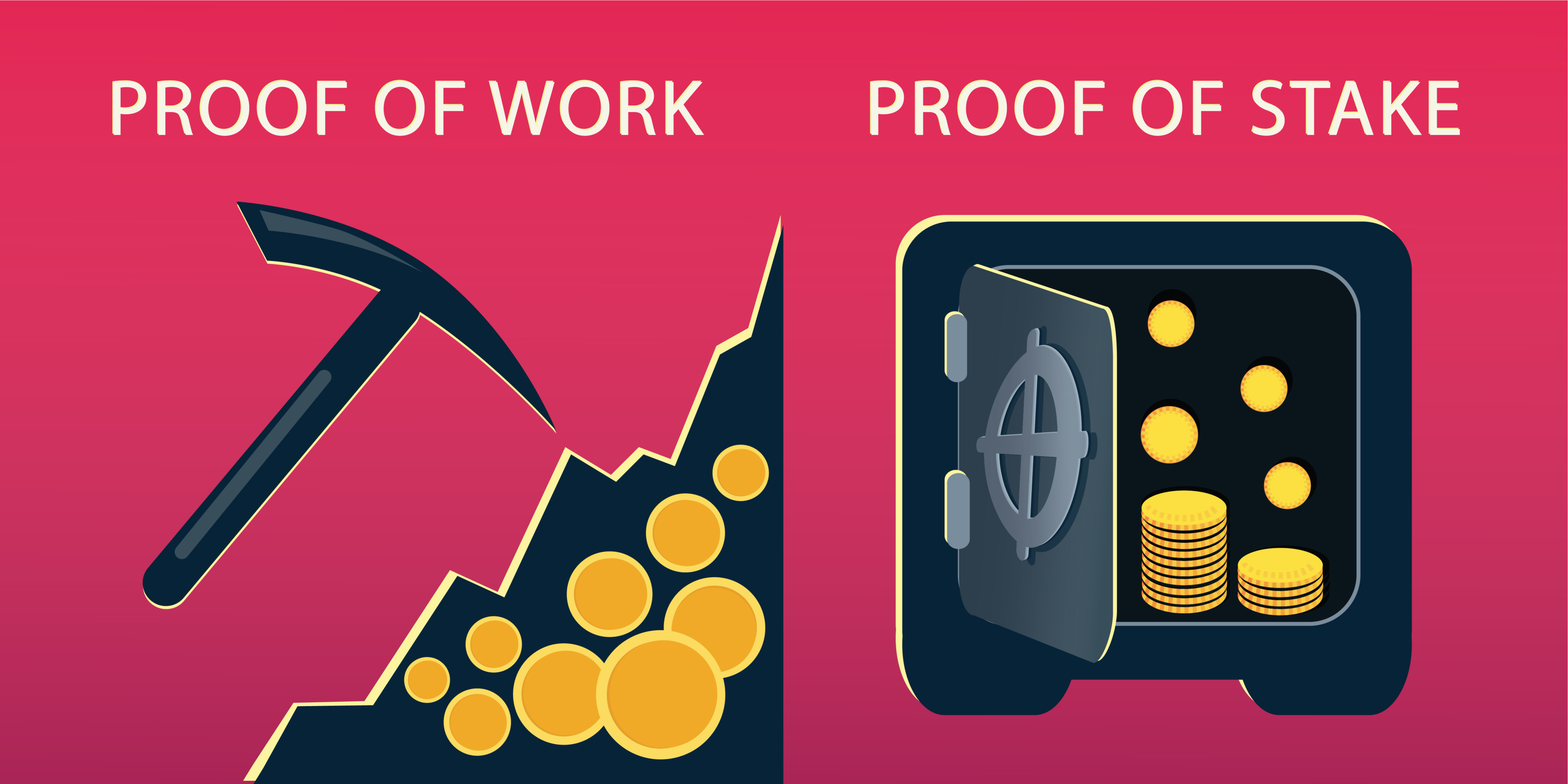On September 15, 2022, Ethereum’s long-awaited Merge was executed, marking the network’s transition from a Proof of Work (PoW) to Proof of Stake (PoS) consensus mechanism. As this content was written pre-Merge, any mentions of Ethereum using PoW are in reference to the network’s previous consensus mechanism, not its current one.
Bitcoin mining is a complicated, but essential process for maintaining trust in the network.
Without a central authority to handle security and safety, there needs to be a strong peer-to-peer structure in place. The decentralised way of creating one source of truth and security for every Bitcoin transaction is known as proof of work.
But what if it could be done with far less energy? Enter proof of stake. A consensus mechanism that is gaining some traction in crypto due to its affordability and low barrier to entry.
Keep reading to learn all about this methodology. At the end, we’ll also share a list of coins currently using proof of stake to verify their transactions.
What is a Consensus Mechanism?
To understand what proof of stake is, we’ll start with consensus mechanisms. Consensus mechanisms refer to the various types of methods used to maintain trust, validity, and security across a blockchain network.
The method by which this is achieved varies depending on the network. In a centralised system, the consensus mechanism is carried out by one central authority; like a security guard in an office building. The guard is solely responsible for validating the identity of workers scanning into the building, ensuring scanned IDs match up with individual entrants. Everyone working in the building trusts that the security guard does their job, only letting in those who can access the building, and keeping watch over any suspicious activity.
In a decentralised system, no one person has complete control over security. Usually, there are multiple points of control—often called nodes—where validators work collaboratively (or solo) to maintain trust across the system. No one validator has enough power to assert their own control, but collectively they can ensure that no one frauds the system.

Further Reading:Blockchain Fundamentals: A Social Perspective
Consensus mechanisms come in all forms. Bitcoin uses a complex algorithm that validators must solve through pure computational power. When the algorithm is solved, a block on the network is validated. Given how ridiculously complex and unhackable the algorithm is, those using the network trust that the block is valid without the need for a central authority to manage all transactions. Miners will also confirm that the block was validated correctly. This consensus mechanism is often referred to as Proof of Work (PoW).
What is Proof of Stake?
Proof of Stake (PoS) is just one of many types of consensus mechanisms. It was introduced in 2012 as an alternative to the high energy consumption often required for proof of work methods. Where PoW uses raw computational power to validate blocks, PoS invites investors to stake their own crypto, allowing them to become a validator on the network. The inclusion of the validator's assets invites them to reach a consensus that is true and fair.
Failure to follow the rules has various consequences depending on the network. In many cases, the network will “slash” the validator, causing them to lose a portion of their stake. The amount lost depends on protocols implemented by the network. Repeat misbehaviour could lead to loss of validator status.
It’s this potential to lose crypto that motivates the validators to remain trustworthy in their autonomy.
How PoS Works
In a proof of stake system, there are no complex and arbitrary computational problems to solve. In most cases, validators can use the technology they have at hand to validate and attest blocks. A step-by-step process follows:
1. An investor stakes their crypto on their chosen PoS network.
a. After meeting the staking threshold, the investor could become a validator. Though if a network has a validator limit and all spots are filled, this step could be delayed.
2. Validators are selected at random and anonymously grouped together. Networks often use a specific, weighted algorithm to prioritise validators with a larger stake.
3. One validator proposes a new block for review.
4. Other validators “attest” that they have seen the block and confirm that it is true.
5. After a certain number of attestations, the block is validated and added to the network.
6. Validators receive a reward for their participation and the group of autonomous participants is disbanded.
7. Failure to participate when randomly selected or attempting to validate a fraudulent block can lead to the loss of any staked cryptocurrency.
Recommended Reading: The Big Four: Smart Contract Platforms
Benefits & Drawbacks in Proof of Stake
Benefits
- Extremely energy efficient when compared to Proof of Work methods
- Lower transaction costs for investors, due to its greater scalability
- Lower technological barrier to entry
Drawbacks
- Validators can lose their stake if they do not participate in the game when selected
- No control over when you’ll be selected
- May not be favourable for investors who prefer frequent trades over holding for the longer term
Proof of Work vs. Proof of Stake
While there’s no such thing as a right or wrong consensus mechanism, there are some differences between the two prominent options which make them viable for various use cases.
Proof of Work relies on the computational effort a validator makes to confirm a transaction.
Proof of Stake relies on the availability of the validator to confirm a transaction through staking their own assets as an assurance that they will carry out the job.

While there are usually fewer active validators involved in Proof of Work networks, the algorithms tend to be more complex to solve. So one could infer that these networks could be more secure. Given the high-level problem solving involved in confirming transactions, these networks usually take longer to process transactions.
Proof of Stake networks thrive on having many validators contributing to the network. This process is still very secure but involves less arbitrary cryptography. With a high amount of validators on the network, proof of stake operations may have a great potential to scale over time.They also tend to have faster transaction speeds.
Coins Using PoS Networks
Below are the top 5 coins by market capitalisation currently using the proof of stake consensus mechanism to verify transactions:
- Cardano
- Solana
- Algorand
- Tezos
- Celo
Diversify Your Crypto Portfolio
Having a wide variety of coins, including those that operate on a proof of stake mechanism, might give some added stability to an ever-volatile market. Although far from penetrating Bitcoin’s PoW model, PoS is gaining interest and wider adoption. Even Ethereum has plans to adopt the consensus mechanism later this year.
Your Proof of Stake Questions Answered
What is proof of stake?
Proof of stake is a consensus mechanism used on various blockchain networks. Investors become validators through staking their own crypto and eventually validating blocks for rewards.
What date will Ethereum move to proof of stake?
Although no specific date has been set, Ethereum plans to move to a complete proof of stake model before the end of 2022.
If I currently have Ether, what do I need to do to prepare for the merge?
Nothing. Your ETH will remain unaffected by the change.
What are some proof of stake coins I can invest in today?
Cardano & Solana are both top 10 cryptocurrencies by market cap, but we’ve also included a list of the top five above.
Got more questions? Check out our blog for more deep dives like this one, or get in contact with a broker today to discuss your crypto investing opportunities.
from Caleb & Brown Cryptocurrency Brokerage.






